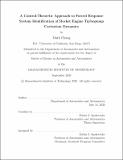| dc.contributor.advisor | Zoltán S. Spakovszky. | en_US |
| dc.contributor.author | Chang, Mark,S.M.Massachusetts Institute of Technology. | en_US |
| dc.contributor.other | Massachusetts Institute of Technology. Department of Aeronautics and Astronautics. | en_US |
| dc.date.accessioned | 2021-01-06T18:33:47Z | |
| dc.date.available | 2021-01-06T18:33:47Z | |
| dc.date.copyright | 2020 | en_US |
| dc.date.issued | 2020 | en_US |
| dc.identifier.uri | https://hdl.handle.net/1721.1/129194 | |
| dc.description | Thesis: S.M., Massachusetts Institute of Technology, Department of Aeronautics and Astronautics, September, 2020 | en_US |
| dc.description | Cataloged from student-submitted PDF of thesis. | en_US |
| dc.description | Includes bibliographical references (pages 163-164). | en_US |
| dc.description.abstract | High performance turbopumps are used in many rocket propulsion systems to reduce the weight and cost of the system. However, to meet these weight conditions and the demands of the rocket engine, turbopumps must operate at high speeds and low inlet pressures. This can lead to cavitation in the turbopump inducer. There are several distinct types of cavitation dynamics. Of concern to this project is cavitation surge which are planar oscillations in the flow that occur at frequencies usually 0.1 - 0.3 times rotor frequency. Cavitation surge can cause the turbopump to modulate the mass flow into the rocket engine combustion chamber and thus yield variations in engine thrust. This in turn can lead to self excited fluid-structure oscillations and POGO instability which can result in mission failure. Characterization of the cavitating inducer dynamics is critical to the design of the propulsion system so as to guarantee sufficient stability margin. This thesis introduces a control theoretic modeling framework that captures the free response cavitation dynamics of turbopump inducers. The reduced order framework was then used to guide the design of a forced response experiment. The design of experiment included the placement of sensors, a piston actuator, and an accumulator to ensure high signal to noise ratio and coherence. Forced response experiments were carried out to experimentally validate the model, and to characterize the cavitation surge dynamics. The experiments identified challenges with the test facility, specifically vibrations of the piping and support structure which induced large fluid perturbations. Due to time constraints and COVID-19, a second test was not possible. This thesis provides useful guidelines and best practices paving the way for future forced response system identification experiments. | en_US |
| dc.description.statementofresponsibility | by Mark Chang. | en_US |
| dc.format.extent | 164 pages | en_US |
| dc.language.iso | eng | en_US |
| dc.publisher | Massachusetts Institute of Technology | en_US |
| dc.rights | MIT theses may be protected by copyright. Please reuse MIT thesis content according to the MIT Libraries Permissions Policy, which is available through the URL provided. | en_US |
| dc.rights.uri | http://dspace.mit.edu/handle/1721.1/7582 | en_US |
| dc.subject | Aeronautics and Astronautics. | en_US |
| dc.title | A Control-theoretic approach to forced response system identification of rocket engine turbopump cavitation dynamics | en_US |
| dc.type | Thesis | en_US |
| dc.description.degree | S.M. | en_US |
| dc.contributor.department | Massachusetts Institute of Technology. Department of Aeronautics and Astronautics | en_US |
| dc.identifier.oclc | 1227279068 | en_US |
| dc.description.collection | S.M. Massachusetts Institute of Technology, Department of Aeronautics and Astronautics | en_US |
| dspace.imported | 2021-01-06T18:33:46Z | en_US |
| mit.thesis.degree | Master | en_US |
| mit.thesis.department | Aero | en_US |
